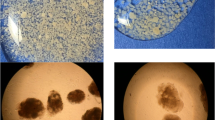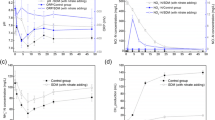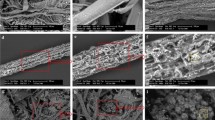Abstract
The microbial communities established in mesophilic and thermophilic expanded granular sludge bed reactors operated with sulfate as the electron acceptor were analyzed using 16S rRNA targeted molecular methods, including denaturing gradient gel electrophoresis, cloning, and phylogenetic analysis. Bacterial and archaeal communities were examined over 450 days of operation treating ethanol (thermophilic reactor) or ethanol and later a simulated semiconductor manufacturing wastewater containing citrate, isopropanol, and polyethylene glycol 300 (mesophilic reactor), with and without the addition of copper(II). Analysis, of PCR-amplified 16S rRNA gene fragments using denaturing gradient gel electrophoresis revealed a defined shift in microbial diversity in both reactors following a change in substrate composition (mesophilic reactor) and in temperature of operation from 30°C to 55°C (thermophilic reactor). The addition of copper(II) to the influent of both reactors did not noticeably affect the composition of the bacterial or archaeal communities, which is in agreement with the very low soluble copper concentrations (3–310 μg l−1) present in the reactor contents as a consequence of extensive precipitation of copper with biogenic sulfides. Furthermore, clone library analysis confirmed the phylogenetic diversity of sulfate-reducing consortia in mesophilic and thermophilic sulfidogenic reactors operated with simple substrates.







Similar content being viewed by others
References
Bak F, Pfennig N (1987) Chemolithotrophic growth of Desulfovibrio sulfodismutans sp. nov. by disproportionation of inorganic sulfur-compounds. Arch Microbiol 147:184–189
Ben-Amor K, Heilig H, Smidt H et al (2005) Genetic diversity of viable, injured, and dead fecal bacteria assessed by fluorescence-activated cell sorting and 16S rRNA gene analysis. Appl Environ Microbiol 71:4679–4689
Boyd JM, Ellsworth H, Ensign SA (2004) Bacterial acetone carboxylase is a manganese-dependent metalloenzyme. J Biol Chem 279:46644–46651
Burggraf S, Jannasch HW, Nicolaus B et al (1990) Archaeoglobus profundus sp. nov, represents a new species within the sulfate-reducing archaebacteria. Syst Appl Microbiol 13:24–28
Chauhan A, Ogram A (2006) Fatty acid-oxidizing consortia along a nutrient gradient in the Florida Everglades. Appl Environ Microbiol 72:2400–2406
Clesceri LS, Greenberg AE, Eaton AD (eds) (1998) Standard methods for the examination of water and wastewater, 20th edn. American Public Health Association, Washington, DC
Dahle H, Birkeland NK (2006) Thermovirga lienii gen. nov., sp nov., a novel moderately thermophilic, anaerobic, amino-acid-degrading bacterium isolated from a North Sea oil well. Int J Syst Evol Microbiol 56:1539–1545
Dar SA, Yao L, Van Dongen U et al (2007) Diversity and activity of sulfate reducing bacterial communities in sulfidogenic bioreactors using 16S rRNA and dsrB genes as molecular markers. Appl Environ Microbiol 73:594–604
Daumas S, Cordruwisch R, Garcia JL (1988) Desulfotomaculum geothermicum sp. nov., a thermophilic, fatty acid-degrading, sulfate-reducing bacterium isolated with H2 from geothermal ground-water. Anton Leeuwen 54:165–178
Davies R, Stephenson M (1941) Studies on the acetone-butyl-alcohol fermentation. 1. Nutritional and other factors involved in the preparation of active suspensions of Clostridium acetobutylicum (Weizmann). Biochem J 35:1320–1331
Dwyer D, Tiedje J (1986) Metabolism of polyethylene glycol by two anaerobic bacteria, Desulfovibrio desulfuricans and a Bacteroides sp. Appl Environ Microbiol 52:852–856
Egert M, Wagner B, Lemke T, Brune A et al (2003) Microbial community structure in midgut and hindgut of the humus-feeding larva of Pachnoda ephippiata (Coleoptera: Scarabaeidae). Appl Environ Microbiol 69:6659–6668
Ekiel I, Sprott GD, Patel GB (1985) Acetate and CO2 assimilation by Methanothrix concilii. J Bacteriol 162:905–908
Ensign SA, Small FJ, Allen JR, Sluis MK (1998) New roles for CO2 in the microbial metabolism of aliphatic epoxides and ketones. Arch Microbiol 169:179–187
Fardeau ML, Salinas MB, L’Haridon S et al (2004) Isolation from oil reservoirs of novel thermophilic anaerobes phylogenetically related to Thermoanaerobacter subterraneus: reassignment of T. subterraneus, Thermoanaerobacter yonseiensis, Thermoanaerobacter tengcongensis and Carboxydibrachium pacificum to Caldanaerobacter subterraneus gen. nov., sp nov., comb. nov. as four novel subspecies. Int J Syst Evol Microbiol 54:467–474
Felsenstein J (1985) Confidence-limits on phylogenies – an approach using the bootstrap. Evolution 39:783–791
Felske A, Wolterink A, Van Lis R, Akkermans ADL (1998) Phylogeny of the main bacterial 16S rRNA sequences in Drentse A grassland soils (The Netherlands). Appl Environ Microbiol 64:871–879
Fukui M, Teske A, Assmus B et al (1999) Physiology, phylogenetic relationships, and ecology of filamentous sulfate-reducing bacteria (genus Desulfonema). Arch Microbiol 172:193–203
Garcia JL (1990) Taxonomy and ecology of methanogens. Fems Microbiol Rev 87:297–308
Grosskopf R, Janssen PH, Liesack W (1998) Diversity and structure of the methanogenic community in anoxic rice paddy soil microcosms as examined by cultivation and direct 16S rRNA gene sequence retrieval. Appl Environ Microbiol 64:960–969
Hattori S, Kamagata Y, Hanada S et al (2000) Thermacetogenium phaeum gen. nov., sp nov., a strictly anaerobic, thermophilic, syntrophic acetate-oxidizing bacterium. Int J Syst Evol Microbiol 50:1601–1609
Henry EA, Devereux R, Maki JS et al (1994) Characterization of a new thermophilic sulfate-reducing bacterium – Thermodesulfovibrio yellowstonii, gen. nov. and sp. nov. – its phylogenetic relationship to Thermodesulfobacterium commune and their origins deep within the bacterial domain. Arch Microbiol 161:62–69
Hernandez-Eugenio G, Fardeau ML, Patel BKC et al (2000) Desulfovibrio mexicanus sp nov., a sulfate-reducing bacterium isolated from an upflow anaerobic sludge blanket (UASB) reactor treating cheese wastewaters. Anaerobe 6:305–312
Hollingsworth J, Sierra-Alvarez R, Zhou M et al (2005) Anaerobic biodegradability and methanogenic toxicity of key constituents in copper chemical mechanical planarization effluents of the semiconductor industry. Chemosphere 59:1219–1228
Hoover RB, Pikuta EV, Bej AK et al (2003) Spirochaeta americana sp nov., a new haloalkallphilic, obligately anaerobic spirochaete isolated from soda Mono Lake in California. Int J Syst Evol Microbiol 53:815–821
Janssen PH, Schink B (1995a) Catabolic and anabolic enzyme-activities and energetics of acetone metabolism of the sulfate-reducing bacterium Desulfococcus biacutus. J Bacteriol 177:277–282
Janssen PH, Schink B. 1995b. Metabolic pathways and energetics of the acetone-oxidizing, sulfate-reducing bacterium, Desulfobacterium cetonicum. Arch Microbiol 163:188–194
Jiang B, Parshina SN, van Doesburg W et al (2005) Methanomethylovorans thermophila sp nov., a thermophilic, methylotrophic methanogen from an anaerobic reactor fed with methanol. Int J Syst Evol Microbiol 55:2465–2470
Joulian C, Patel BKC, Ollivier B et al (2000) Methanobacterium oryzae sp nov., a novel methanogenic rod isolated from a Philippines ricefield. Int J Syst Evol Microbiol 50:525–528
Kaksonen AH, Plumb JJ, Franzmann PD et al (2004) Simple organic electron donors support diverse sulfate-reducing communities in fluidized-bed reactors treating acidic metal- and sulfate-containing wastewater. Fems Microbiol Ecol 47:279–289
Karri S, Sierra-Alvarez R, Field JA (2006) Toxicity of copper to acetoclastic and hydrogenotrophic activities of methanogens and sulfate reducers in anaerobic sludge. Chemosphere 62:121–127
Kashefi k, Holmes DE, Baross JA et al (2003) Thermophily in the Geobacteraceae: Geothermobacter ehrlichii gen. nov., sp. nov., a novel thermophilic member of the Geobacteraceae from the “Bag City” hydrothermal vent. Appl Environ Microbiol 69:2985–2993
Konstantinov SR, Awati AA, Williams BA et al (2006) Post-natal development of the porcine microbiota composition and activities. Environ Microbiol 8:1191–1199
Lane D (1991) 16S/23S rRNA sequencing. In: Stackebrandt E, Goodfellow M (eds) Nucleic acid techniques in bacterial systematics. Wiley & Sons Ltd, Chichester, UK, pp 115–175
Leclerc M, Delgenes JP, Godon JJ (2004) Diversity of the archaeal community in 44 anaerobic digesters as determined by single strand conformation polymorphism analysis and 16S rDNA sequencing. Environ Microbiol 6:809–819
Lens PNL, Visser A, Janssen AJH et al (1998) Biotechnological treatment of sulfate-rich wastewaters. Crit Rev Environ Sci Technol 28:41–88
Liu JR, Tanner RS, Schumann P et al (2002) Emended description of the genus Trichococcus, description of Trichococcus collinsii sp nov., and reclassification of Lactosphaera pasteurii as Trichococcus pasteurii comb. nov and of Ruminococcus palustris as Trichococcus palustris comb. nov in the low-G+C Gram-positive bacteria. Int J Syst Evol Microbiol 52:1113–1126
Lomans BP, Maas R, Luderer R, den Camp H et al (1999) Isolation and characterization of Methanomethylovorans hollandica gen. nov., sp nov., isolated from freshwater sediment, a methylotrophic methanogen able to grow on dimethyl sulfide and methanethiol. Appl Environ Microbiol 65:3641–3650
Ludwig W, Strunk O, Westram R et al (2004) ARB: a software environment for sequence data. Nucleic Acids Res 32:1363–1371
Ma K, Liu XL, Dong XZ (2005) Methanobacterium beijingense sp nov., a. novel methanogen isolated from anaerobic digesters. Int J Syst Evol Microbiol 55:325–329
Ma K, Liu XL, Dong XZ (2006) Methanosaeta harundinacea sp nov., a novel acetate-scavenging methanogen isolated from a UASB reactor. Int J Syst Evol Microbiol 56:127–131
McGinnis S, Madden TL (2004) BLAST: at the core of a powerful and diverse set of sequence analysis tools. Nucleic Acids Res 32:W20–W25
Muyzer G, Dewaal EC, Uitterlinden AG (1993) Profiling of complex microbial-populations by denaturing gradient gel-electrophoresis analysis of polymerase chain reaction-amplified genes-coding for 16S ribosomal RNA. Appl Environ Microbiol 59:695–700
Nanninga HJ, Gottschal JC (1987) Properties of Desulfovibrio carbinolicus sp. nov. and other sulfate-reducing bacteria isolated from an anaerobic-purification plant. Appl Environ Microbiol 53:802–809
Nubel U, Engelen B, Felske A et al (1996) Sequence heterogeneities of genes encoding 16S rRNAs in Paenibacillus polymyxa detected by temperature gradient gel electrophoresis. J Bacteriol 178:5636–5643
O’Flaherty V, Colleran E (1999) Effect of sulphate addition on volatile fatty acid and ethanol degradation in an anaerobic hybrid reactor. I: process disturbance and remediation. Bioresource Technol 68:101–107
Oude-Elferink S, Luppens SBI, Marcelis CLM et al (1998) Kinetics of acetate oxidation by two sulfate reducers isolated from anaerobic granular sludge. Appl Environ Microbiol 64:2301–2303
Patel GB, Sprott GD (1990) Methanosaeta concilii gen. nov, sp. nov (Methanothrix concilii) and Methanosaeta thermoacetophila nom. rev, comb. nov. Int J Syst Bacteriol 40:79–82
Platen H, Temmes A, Schink B (1990) Anaerobic dgradation of acetone by Desulfococcus biacutus spec. nov. Arch Microbiol 154:355–361
Platen H, Schink B (1987) Methanogenic degradation of acetone by an enrichment culture. Arch Microbiol 149:136–141
Platen H, Schink B (1989) Anaerobic degradation of acetone and higher ketones by newly isolated denitrifying bacteria. J Gen Microbiol 135:883–891
Roest K, Altinbas M, Paulo PL et al (2005a) Enrichment and detection of microorganisms involved in direct and indirect methanogenesis from methanol in an anaerobic thermophilic bioreactor. Microb Ecol 50:440–446
Roest K, Heilig H, Smidt H et al (2005b) Community analysis of a full-scale anaerobic bioreactor treating paper mill wastewater. Syst Appl Microbiol 28:175–185
Scheff G, Salcher O, Lingens F (1984) Trichococcus flocculiformis gen nov. sp. nov. a new Gram-positive filamentous bacterium isolated from bulking sludge. Appl Microbiol Biotechnol 19:114–119
Schink B, Stieb M (1983) Fermentative degradation of polyethylene glycol by a strictly anaerobic, gram-negative, non-sporeforming bacterium, Pelobacter venetianus sp. nov. Appl Environ Microbiol 45:1905–1913
Schramm E, Schink B (1991) Ether-cleaving enzyme and diol dehydratase involved in anaerobic polyethylene glycol degradation by a new Acetobacterium sp. Biodegradation 2:71–79
Schuppert B, Schink B (1990) Fermentation of methoxyacetate to glycolate and acetate by newly isolated strains of Acetobacterium sp. Arch Microbiol 153:200–204
Stahl DA, Fishbain S, Klein M et al (2002) Origins and diversification of sulfate-respiring microorganisms. Antonie Leeuwen 81:189–195
Stetter KO, Huber R, Blochl E et al (1993) yperthermophilic archaea are thriving in deep North Sea and Alaskan oil reservoirs. Nature 365:743–745
Stumm W, Morgan JJ (1996) Aquatic chemistry: chemical equilibria and rates in natural waters, 3rd edn. John Wiley & Sons, Inc, New York, USA
Tanaka K, Pfennig N (1988) Fermentation of 2-methoxyethanol by Acetobacterium malicum sp. nov. and Pelobacter venetianus. Arch Microbiol 149:181–187
Trüper HG, Schlegel HG (1964) Sulphur metabolism in thiorhodaceae: quantitative measurements on growing cells of Chromatium okenii. Antonie Leeuwen 30:225–238
Utgikar VP, Chen BY, Chaudhary N, Tabak HH, Haines JR, Govind R (2001) Environ. Toxicol Chem 20:2662–2669
Visser A, Nozhevnikova AN, Lettinga G (1993) Sulfide inhibition of methanogenic activity at various pH levels at 55°C. J Chem Technol Biotechnol 57:9–13
Wagener S, Schink B (1988) Fermentative degradation of nonionic surfactants and polyethylene-glycol by enrichment cultures and by pure cultures of homoacetogenic and propionate-forming bacteria. Appl Environ Microbiol 54:561–565
Wagner R (1994) The regulation of ribosomal RNA synthesis and bacterial cell growth. Arch Microbiol 161:100–109
Widdel F (1986) Growth of methanogenic bacteria in pure culture with 2-propanol and other alcohols as hydrogen donors. Appl Environ Microbiol 51:1056–1062
Yamada T, Sekiguchi Y, Imachi H et al (2005) Diversity, localization, and physiological properties of filamentous microbes belonging to Chloroflexi subphylum I in mesophilic and thermophilic methanogenic sludge granules. Appl Environ Microbiol 71:7493–7503
Yamada T, Sekiguchi Y, Hanada S et al (2006) Anaerolinea thermolimosa sp nov., Levilinea saccharolytica gen. nov., sp nov and Leptolinea tardivitalis gen. nov., so. nov., novel filamentous anaerobes, and description of the new classes Anaerolineae classis nov and Caldilineae classis nov in the bacterial phylum Chloroflexi. Int J Sys Evol Microbiol 56:1331–1340
Zeikus JG, Wolfe RS (1972) Methanobacterium thermoautotrophicus sp n, an anaerobic, autotrophic, extreme thermophile. J Bacteriol 109:707–713
Acknowledgments
Financial support from the National Institute of Health (NIH grant TW00036) and the NSF/SRC Engineering Research Center for Environmentally Benign Semiconductor Manufacturing is acknowledged. M.A. was supported by fellowships from the Scientific and Technical Research Council of Turkey, and the Wageningen Institute for Environment and Climate Research. R.S.A. was supported by the National Science Foundation (NSF-0137368). We are thankful to Hans G.H.J. Heilig for his excellent assistance with DGGE analyses.
Author information
Authors and Affiliations
Corresponding author
Rights and permissions
About this article
Cite this article
Freeman, S.A., Sierra-Alvarez, R., Altinbas, M. et al. Molecular characterization of mesophilic and thermophilic sulfate reducing microbial communities in expanded granular sludge bed (EGSB) reactors. Biodegradation 19, 161–177 (2008). https://doi.org/10.1007/s10532-007-9123-9
Received:
Accepted:
Published:
Issue Date:
DOI: https://doi.org/10.1007/s10532-007-9123-9




